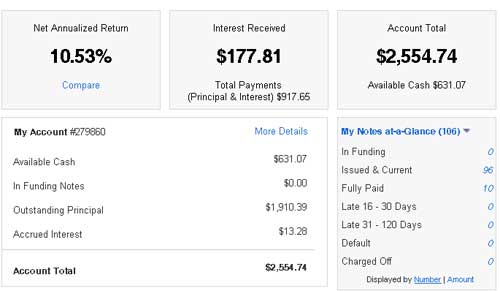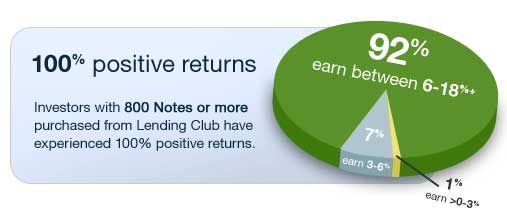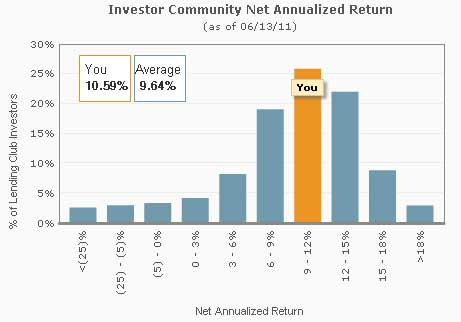Lending Club launched a couple of years back and along with a few other companies helped to create a whole new banking paradigm, one where people lend their money to other people and get better returns on their money than if they had saved with a traditional bank. In turn, the people who are borrowing end up getting a lower rate than they may have at a traditional bank, and are able to save some money in the process.
While the road hasn’t been without it’s speed bumps, Lending Club has weathered the storm, and in my opinion has become the premier peer to peer lending site around. While others are starting to catch up to them in some respects, like the folks at Prosper, I still think they’re the gold standard when it comes to P2P lending sites.
I’ve been pretty happy with the returns that I’ve seen with my Lending Club account. When I first started using it I was expecting that I would put a small amount of money into it, and that I would probably see some defaults here and there. I wasn’t ever expecting to put anything more than a bit of fun money in there, and I didn’t think the returns would be as good as they’ve been. I thought they might be a bit better (after defaults) than what I’m seeing at my high yield savings account. The reality has been much brighter. I’m currently making over 10.5% on my invested money after just over 2 years, and I’ve yet to see a single default. At the same time I get to have the good feeling of helping others to get loans at lower rates than they would get at a traditional bank or via a credit card. It’s a great way to consolidate higher interest debt. So how are my returns right now, and what strategy am I using?
Check out my original Lending Club review
Lending Club Returns Above 10.5%
So here’s a quick look at the returns I’ve been seeing lately after including more high risk loans over the past 8 months or so.
- Net Annualized Return of 10.53%: Up from 10.17% in April, and 9.67% before that. That puts me in the 53rd percentile, in other words my return is higher than 53% and lower than 47% of all investors. My goal is to be doing better than 1/2 of Lending Club users, and it looks like I’ve now reached that goal. Of course I’ll still be trying to improve that number!
- Number of defaults remains at zero: Despite all odds I’m still showing zero defaults on my account, despite having given out over 100 loans so far. I’m actually surprised I haven’t had at least one or two.
- Ten loans have been paid off early: Eight were A grade loans, and the other two were C grade loans. Looks like grade A loans, while they’re more likely to be paid back, may also be more likely to pay of early – reducing returns.
- My account balance still going up: I currently have $2,554.74 in my account, with another $600+ ready to invest. I’m starting to become more comfortable with using Lending Club, and as such adding more most months.
- I’m still diversified by investing across a large number of loans: I’ve got over 100, with no more than $25 in each loan. That way if I do have defaults, while my return may go down, my risk will be minimized. Lending Club noted earlier this month, that 100% of their investors who have invested 800 notes or more had positive returns. Not too shabby, not everyone in the stock market can say that!
So it looks like my strategy I laid out a few months ago of adding more risky C, D and F grade loans is paying off so far.
Riskier Loans Aren’t Always Bad Bets
As I’ve mentioned in the past about 8 months ago I modified my investing strategy a bit based off of the plan laid out by Matt at steadfastfinances.com. He started a Lending Club investing club where he would hand pick loans every week or two, based off of his own investing criteria. Part of his strategy was investing in lower grade loans to borrowers who he thought would be good risks. Most of the loans he was looking at and choosing were higher risk C or D grade loans, for people with lower credit scores, but who had a good high paying professions, solid job histories and job security, and good payment histories. Using his strategy he was seeing in excess of 14% returns at one point.
Using his strategy I’ve been able to get my returns from somewhere in the 8-9% range to up over 10.5% in about 8 months. I’d like to see if I can get my net annualized return up even closer to 11-12% by continuing this strategy.
Here’s where my NAR stands now, slightly above average. I hope to move up a couple of columns there:
My Strategy For Investing With Lending Club
My strategy I used in the past for Lending Club, and the strategy I’ll still be using to some degree:
- Less than $10,000: I believe I’ll still be sticking with mostly loans below $10,000. Lower amounts mean higher likelihood of payback of the loan.
- Zero delinquencies: Again, I may fudge slightly on this one, but I still want it to be very few or zero delinquencies.
- Debt to income ratio below 20-25%: I like to invest in loans where the borrowers have a lower DTI ratio, and preferably have higher incomes. I’ll try to keep this as is.
- Borrower answers to investor questions: I like to ask questions from potential borrowers. You can tell a lot about someone, and about how they’ll do repaying the loan, by how they answer the questions. Unfortunately Lending Club stopped allowing investors to ask questions in part I believe because of privacy and liability concerns. You can now only ask from a pre-set list of questions. More than one investor – including Matt who I mentioned above, have quit Lending Club because of this change.
So that’s what I’m doing with my Lending Club portfolio right now, and how I’m investing.
Not ready to invest, but looking to consolidate debt or pay off a high interest credit card? You might want to consider borrowing from Lending Club. Check out my post on borrowing from Lending Club.
Are you currently investing in Lending Club? How are your returns looking? Tell us in the comments!





Congratulations Peter, to be an investor for over two years and not have a single default (or even a single late loan right now for that matter) is quite an achievement. And your change in strategy seems to be working.
Now, with you doing so well it might be presumptuous of me to recommend a tweak to your criteria but I will anyway :-). When you get into the C and D grade notes I would urge you to consider one more criteria: inquiries = 0. This will remove those people who are out shopping for lots more credit and are thus higher risks. That’s my 2c.
That’s a great criteria to consider, thanks for suggesting it!
By the way I had a couple of late loans earlier this year, but those borrowers got back to being current on their loans. Hopefully they won’t be late again.
I have been using lending club now for a couple of years and I have not been as fortunate. I have had several loans actually be charged off with yet another that will be charged off this month. I only put a few hundred dollars in as I was still not comfortable with it so I have not lost too much but it is not the results I was hoping for.
Maybe once the economy starts to even out things will improve but for now I am going to stay very cautious with whom I lend to on Lending Club.
This is a very impressive return. It does sound as if you have a very good screening mechanism or are very lucky to not have any defaults. If the economy starts to recover, it may improve the overall track record of defaults.
How easy is it to start an investment club through lending club and do you need to be licensed to manage this club?
Who pays the tax liability in an investment club?
How long does it typically take for a borrower to get the funding he has requested once given a grade by lending club?
Hey Peter, nice job increasing your returns.
I’ve been able to recently increase mine to 10.85%, and I’ve been investing for about two years now as well.
I’ve had a few loans in the grace period, but they’re all up-to-date now, with no delinquencies.
Sticking to 3-year loans that are B-grade, with long credit history and no late payments, has been my criteria.
By the way, do they still offer the $25 bonus for new investors?